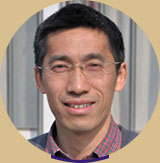

博士,教授,博士生导师。1991年本科毕业于浙江大学化学系,获学士学位 (化学专业)。分别于1994、1998年在浙大获硕士、博士学位 (物理化学专业)。1999-2000年在柏林洪堡大学生物系分子生物物理专业从事博士后研究。2001-2003年间又两次回到该系及到台湾中山大学化学系继续研究工作。2004年12月进入复旦大学生命科学学院工作,2005年起历任副教授、教授。
CRISPR-Cas9的DNA剪切活性结构研究
由细菌获得性免疫系统发展出的CRISPR-Cas9技术已成为革命性的基因编辑工具,在生物医学领域有着巨大的应用潜力。为了解该系统的DNA剪切机理、指导系统的优化,过去几年人们已陆续解析了多个“Cas9-sgRNA-DNA靶链”的三元复合物结构。然而,这些复合物结构并没有完全揭示出真正的DNA剪切活性构象,人们对CRISPR-Cas9如何通过HNH与RuvC核酸酶域切割DNA的分子机制还很不明确。针对此问题,我们用冷冻电镜单颗粒三维重构方法解析了酿脓链球菌Cas9酶 (SpCas9)、sgRNA和DNA的三元复合物结构。该结构的原子模型显示,在已解析的所有结构中,该复合物的HNH酶活性中心最接近DNA链的切割位点;分子动力学模拟及点突变实验表明,该复合物的HNH和RuvC核酸酶活性中心可以与DNA解旋单链形成切割反应所需构象。因此,研究获得了CRISPR-Cas9的DNA剪切激活构象,为全面揭示DNA剪切机理提供了关键的活性结构信息,并为应用蛋白质工程技术优化该系统、降低其脱靶效应提供了重要的结构生物化学基础。
遗传工程学:基因编辑系统的结构生物化学与前沿技术;医学遗传学:癌症药物分子设计(小分子、蛋白质或核酸药物);结构生物信息学:生物分子结构与相互作用的理论和模拟。
1. C. Huai, G. Li, R. Yao, Y. Zhang, M. Cao, L. Kong, C. Jia, H. Yuan, H. Chen, D. Lu*, Q. Huang*. (2017). Structural insights into DNA cleavage activation of CRISPR-Cas9 system. Nature Communications. 8:1375.
2. H. Yuan, J. Wu, X. Wang, J. Chen, Y. Zhong, Q. Huang*, P. Nan*. (2017). Computational identification of amino-acid mutations that further improve the activity of a chalcone-flavonone isomerase from Glycine max. Frontiers in Plant Science. 8:248.
3. Q. Huang, L. Yu, A. J. Levine, R. Nussinov, B. Ma. (2014). Dipeptide analysis of p53 mutations and evolution of p53 family proteins. Biochimica et Biophysica Acta-Proteins and Proteomics. 1844:198-206.
4. J. Zhu, Q. Yang, D. Dai, Q. Huang*. (2013). X-ray crystal structure of phosphodiesterase 2 in complex with a highly selective, nanomolar inhibitor reveals a binding-induced pocket important for selectivity.Journal of the American Chemical Society. 135: 11708-11711.
5. M. Xu, L. Yu, B. Wan, L. Yu, Q. Huang*. (2011). Predicting inactive conformations of protein kinases using active structures: conformational selection of type-II inhibitors. PLoS One. 6:e22644.
6. C. You#, Q. Huang#, H. Xue, Y. Xu, H. Lu. (2010). Hydrophobic interaction between two cysteines in interior hydrophobic region of protein improves thermostability of a family 11 xylanase from Neocallimastix patriciarum. Biotechnology and Bioengineering. 105: 861-870. (# contributed equally)
7. H. Shen, F. Xu, H. Hu, F. Wang, Q. Wu, Q. Huang*, H. Wang*. (2008). Coevolving residues of (beta/alpha)8-barrel proteins play roles in stabilizing active site architecture and coordinating protein dynamics. Journal of Structural Biology. 164: 281-292.
8. Q. Huang, C.- L. Chen, A. Herrmann. (2004). Bilayer conformation of fusion peptide of influenza virus hemagglutinin: a molecular dynamics simulation study. Biophysical Journal. 87:14-22.
9. Q. Huang, S. Ding, C. Y. Hua, H. C. Yang, C. L. Chen. (2004). A computer simulation study of water drying at the interface of protein chains. Journal of Chemical Physics. 121:1969-1977.
10. Q. Huang, R. Opitz, E.-W. Knapp, A. Herrmann. (2002). Protonation and stability of the globular domain of influenza virus hemagglutinin. Biophysical Journal. 82:1050-1058.